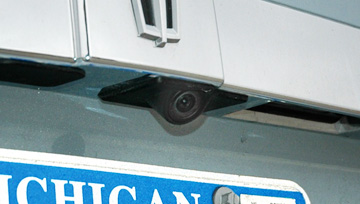
TROY, MI – Automotive vision systems are proliferating today, particularly with rearward-facing cameras designed to let drivers spot objects behind the vehicle when backing up.
The safety benefits can be profound, and a federal mandate for the technology is now in the works.
But the technology comes with a hitch: The cameras, generally tucked into a recess in the liftgate or trunk lid, are so compact that the lens gives the driver a skewed perspective of the proximity to an object.
Magna International Inc.’s electronics division has managed to partially flatten out that “fish-eye” effect when the image appears on an LCD screen on the dashboard, or in the rear-view mirror.
A key supplier of the technology for the past two years, Magna Electronics expects about a half million new vehicles this year to deploy its ReversAid system.
The supplier’s latest version appears in the all-new Lincoln MKS, and it is an improvement over previous-generation systems. The new device also launches for another domestic OEM later this year, executives say.

The problem with older systems is they gave a false sense of security, convincing drivers they had plenty of space for backing up if they relied solely on the dashboard image. Once they turned their heads to see how close they actually were to an object – say, a light pole in a parking lot – the drivers were alarmed to find the object much too close for comfort.
For the new ReversAid system, Magna engineers have written software that corrects much of the problem, while still giving the lens a field of vision of about 135 degrees. The broader the field of vision, the more pronounced the fish-eye effect.
In the MKS, the image that appears on the dashboard is of higher quality and better manages bright light and glare. The fish-eye effect has not been completely eliminated, but it’s not as severe as in earlier systems.
The complimentary metal-oxide semiconductor image sensor is the same, but the software now is integrated into the camera, rather than requiring a separate electronic controller.
“It’s a much smaller package,” says Mike O’Sullivan, Magna Electronics’ director-sales and marketing North America and Asia. “It saves the OEM in terms of labor content, and there are wiring and connector savings.”
The updated software processes the image, corrects the distortion effect and then outputs the new image. In addition, the ReversAid system adds color graphic overlays to show the intended path of the vehicle as it backs up, based on steering angle.

In the new MKS application, four ultrasonic sensors in the rear bumper also are integrated to detect an object as the vehicle backs up. The closer the object comes to the vehicle, the more rapid the beeping to serve as a warning.
The market for ReversAid and other competitive systems could be on a rapid trajectory. O’Sullivan says the National Highway Traffic Safety Admin. likely will require all new vehicles to be equipped with rear-vision systems as part of the Cameron Gulbransen Kids Transportation Safety Act of 2007.
Rulemaking is required to begin within a year to revise FMVSS 111 to prevent death and injuries resulting from backing incidents. But camera systems might not be the only solution, as the secretary of transportation may prescribe different approaches to expand rear vision, including additional mirrors, sensors and cameras.
Final standards are expected within three years, and Magna officials suspect the legislation will take effect in 2015.
Magna Electronics produces its ReversAid system and electronic controllers in Holly, MI, while the ultrasonic sensors are sourced from China.


